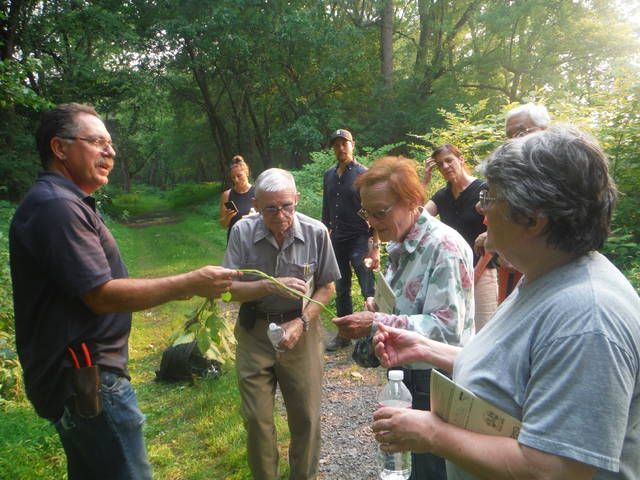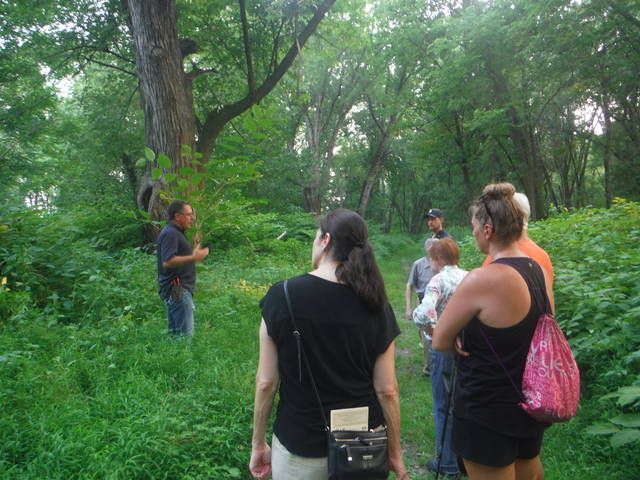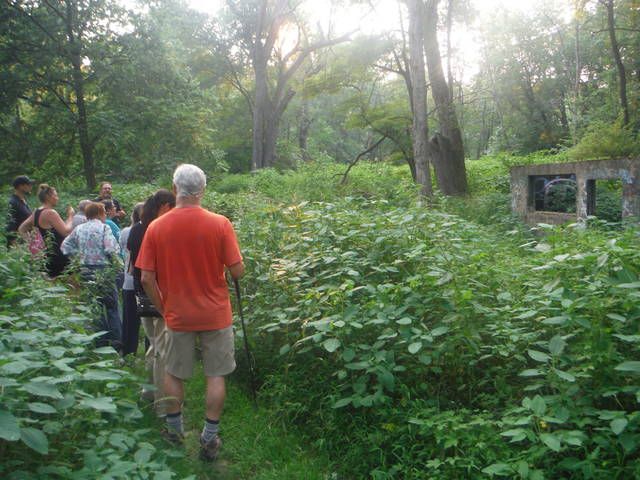
Vinnie Cotrone from the Riverfront Parks Committee, at left, shows the soothing sap inside a piece of jewel weed to Y Walk Wednesday participants.
Mary Therese Biebel | Times Leader
Upcoming guided walks will visit courthouse, colleges
Click here to subscribe today or Login.
Wilkes-Barre’s midweek temperatures, you may recall, were in the 90s.
And as folks who’d signed up for a “Y Walk Wednesday” adventure gathered late Wednesday afternoon at the Wilkes-Barre Family YMCA, a few of them said they wished it were a little cooler.
But walk leader Vinnie Cotrone from the Riverfront Parks Committee, who was about to guide the little group of nine through a “Walk on the Wild Side” of Kirby Park, encouraged them with an incentive:
“Hopefully, you’ll soon physically feel the benefit of the woods.”
He was right. After setting out from the YMCA, the group walked along the east side of the Susquehanna, crossed the Market Street Bridge and entered the riparian — that means “along the river” — forest filled with trees and bushes and … a delightful sense of coolness in the shade.
“People don’t realize how blessed we are here to have the river accessible on both sides,” Cotrone said. “In so many other cities the riverbanks have been industrialized.”
Thanks to the generosity of local philanthropists Abram Nesbitt and Fred Morgan Kirby, Cotrone said, more than 90 acres of land on the west side of the river were set aside during the early 20th century as a place for rest and recreation.
“People worked in mines and factories,” he said, pointing out the park provided an attractive destination for their free time.
Kirby Park’s natural area wasn’t always full of trees and vegetation, the way it is today. There was a time early in the park’s history when you would have found mowed grass, carriage paths, a small zoo and a reflecting pool instead.
But after the St. Patrick’s Day Flood of 1936, the Army Corps of Engineers built a levee system that divided Kirby Park in two.
The part that sees more human activity contains ball fields, tennis courts, pavilions and a running track. The other part was allowed to grow wild, and if you venture there, you’ll find all sorts of trees, from silver maples to staghorn sumac, growing amid herbs and flowers and the occasional berry bush.
“They’re sweet,” hiker Joanna Vivalda of Mountain Top said after picking a few ripe mulberries.
The forested area also contains jewel weed. Squeezing some fluid from the plant, Cotrone told the hikers the sap is a traditional remedy for soothing a poison ivy rash.
Some vegetation he’s not so happy to see in the riparian forest is the prolific knotweed, an invasive plant that prevents native plants from growing. “There’s too much of it,” he said. “It’s very hard to get rid of.”
Another invader that arrived from another continent is the emerald ash borer. While the walkers didn’t see that insect, they saw results of its work. “The trees you see that are dead are all ash trees,” Cotrone said at one point.
As the group made its way through the wooded area, they saw the remains of the reflecting pool, the caretaker’s home and a zoo structure.
And they walked on a macadam path where, Cotrone estimated, people once might have ridden in horse-drawn buggies.
“Keep in mind,” he said, “none of these trees would have been here.”
Make no mistake, Cotrone is grateful for the trees of the riparian forest, which keep contaminants out of the river, clean the air, provide habitat for birds and other wildlife — and can help a group of hikers cool off on a hot day.
“We should get t-shirts that say ‘I survived a walk on the wild side,’ ” Y Walk Wednesday coordinator Michele Schasberger joked as the group made its way back over the bridge toward the YMCA.
“I walk a lot,” participant Elaine Macri of Moutain Top said. “It’s much nicer with a group.”
Macri said she appreciates the knowledge the walk leaders share, not only Cotrone with his nature lore but, on another recent walk, local history expert Tony Brooks with his knowledge of downtown Wilkes-Barre’s mansions.
The rest of the Y Walk Wednesdays series is listed below. All walks begin at 6 p.m. from the entrance of the Wilkes-Barre Family YMCA, corner of South Franklin and West Northampton streets. Walks are about 90 to 120 minutes long. In case or rain or extreme heat, the walk will be postponed until the following evening.
The free walks are limited to 24 attendees. To register, email [email protected] or call 570-970-5040. To find out if a walk is postponed, call the YMCA front desk at 570-823-2191.
July 14, a tour of the Luzerne County Courthouse led by Judge Richard M. Hughes III.
July 21, Storm Water Management in the Wyoming Valley, led by Richard Troscianecki, Master Watershed Steward Coordinator, Penn State Cooperative Extension.
July 28, Journey Through Kings College, led by Michelle Olivia of Undergraduate Admissions and Freddie Pettit of Institutional Advancement, Kings College.
Aug. 4, What’s New Downtown, led by Larry Newman, Executive Director of the Diamond City Partnership, Downtown Wilkes-Barre’s development organization.
Aug. 11, Walking Wilkes University, led by Michael Wood from Wilkes.
Aug. 18, Walking Your Way to a Healthier You, led by YMCA staff.
Aug. 25, LCTA Walk to the Murray Complex led by Lee Horton, executive director of the Luzerne County Transportation Authority.






